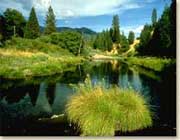Home » Programs » June 2007 Watershed Highlight: Wild and Scenic Environmental Film Festival
June 2007 Watershed Highlight of the Month
Feather River Coordinated Resource Management Group
 The June Watershed Highlight goes to the Feather River Coordinated Resource Management (CRM) group. The Feather River CRM is a partnership of 23 public and private sector groups who formed in 1985 (that’s right… 22 years of watershed restoration work!) to collectively improve watershed health in the upper Feather River Watershed. Over the last 22 years, the Feather River CRM has successfully implemented a total of 91 projects through the support and cooperation of agencies and landowners. Of this total, 54 have been on-the-ground project, 11 studies/strategies, 13 planning and coordination of projects, and 13 education projects. On-the-ground projects have treated approximately 28 miles of stream directly restoring approximately 2,449 acres of meadow/floodplain with the Feather River Watershed. The June Watershed Highlight goes to the Feather River Coordinated Resource Management (CRM) group. The Feather River CRM is a partnership of 23 public and private sector groups who formed in 1985 (that’s right… 22 years of watershed restoration work!) to collectively improve watershed health in the upper Feather River Watershed. Over the last 22 years, the Feather River CRM has successfully implemented a total of 91 projects through the support and cooperation of agencies and landowners. Of this total, 54 have been on-the-ground project, 11 studies/strategies, 13 planning and coordination of projects, and 13 education projects. On-the-ground projects have treated approximately 28 miles of stream directly restoring approximately 2,449 acres of meadow/floodplain with the Feather River Watershed.
Dennis Heiman (Central Valley Regional Water Quality Control Board) says... “I've worked with this program since their beginnings in 1985 and I'm continually impressed and motivated by their level of activity and their general understanding of the needs of the watershed. In the midst of all our agency program activities and requirements (meetings, conference calls, status reports, guidance documents, QAPs, PAEPs, performance monitoring, etc, etc), I find it uplifting to know and see that someone out there is doing actual watershed improvement work. Perhaps you will also.”
About Feather River CRM
The Feather River Coordinated Resource Management (FRCRM) group is a partnership of 23 public and private sector groups who formed in 1985 to collectively improve watershed health in the upper Feather River Watershed. Over 80 watershed projects have been completed including studies and assessments, stream restoration, monitoring, resource management plans, strategic planning, community outreach and educational activities. Over 30 miles of stream and 2,800 riparian acres have been treated over the last twenty years, at a cost of seven million dollars contributed largely by FRCRM partners. The FRCRM recognizes that restoring watershed function is a major priority in reversing erosional trends and improving environmental and economic resources. Stable, well-vegetated streams with functioning meadows, aquifers and uplands are critical in maintaining good watershed condition. Achieving this state begins with reestablishing stability and proper hydrologic function in headwater meadows by reconnecting channels with historic floodplains. This represents the current focus of the FRCRM. Overall, restoration activities play an important role in accelerating improvement in watershed function, the local economy, and downstream uses. Public education is also an essential element to the success of the FRCRM program.
About the Feather River Watershed
The Feather River watershed is located in California's northern Sierra Nevada and encompasses a broad variety of terrain, climate, historic use, and flora and fauna. It drains 3,222 square miles of land base from the Sierran crest westward into the Sacramento River. Elevation ranges from 2,250 to over 10,000 feet, and annual precipitation varies broadly from more than 70 inches on the wet western slopes to less that 12 inches on the arid east side. Vegetation is diverse and ranges from productive mixed conifer and deciduous forests in the west to sparse sage/yellow pine plant communities in the east. The Plumas National Forest manages over 80 percent of the watershed, while alluvial valleys are predominantly privately owned and are grazed by livestock.
The Feather River watershed has long been recognized for its recreational and aesthetic value. An abundance of mountain rivers, lakes and reservoirs dot the landscape, creating both summer and winter recreational opportunities. Water originating from these drainages also represents a significant component of the State Water Project and provides high quality water for hydro generation, agriculture, industry and cities in the south. The Feather River watershed has been impacted by 140 years of intense human use. Past mining, grazing and timber harvest practices, wildfire, railroad and road construction have contributed to the degradation of over 60 percent of the watershed, resulting in accelerated erosion, degraded water quality, decreased vegetation and soil
productivity, and degraded terrestrial and aquatic habitats. Annually, 1.1 million tons of sediment is delivered to Rock Creek Dam at the downstream end of the East Branch North Fork Feather River (EBNFFR) of which 80 percent is attributable to man’s activities. Long-term vegetation disturbance and consequent gully erosion has led to a dramatic change in hydrology, leading to reduced summer flow, higher summer water temperature, lower water tables, reduced meadow storage capacity, and a trend from perennial to intermittent flow. Many downcut streams no longer sustain late-season flow, causing adverse consequences to riparian and upland vegetation, aquatic communities, and downstream water users.
The activities of the FRCRM are intended to reverse these negative trends and improve overall watershed condition through responsible land stewardship and restoration practices.
Get more information about Feather River CRM at http://www.feather-river-crm.org/
|

